The aperture ratio and deep sky astrophotography
Using reducers
A reducer can help by adapting the focal length to suit the object size or the atmospheric conditions.
 Reducers are lens systems that reduce the focal length of the telescope and are available in a range of versions and with different reduction factors. M. Weigand
Reducers are lens systems that reduce the focal length of the telescope and are available in a range of versions and with different reduction factors. M. WeigandReducers serve to reduce the focal length and are often used to achieve a smaller f-number, i.e. the focal length per aperture diameter. It is also not uncommon to read on the Internet that you get more signal on the chip. The aim is to achieve a better signal-to-noise ratio (SNR) – important for creating images of especially distant deep sky objects – or to shorten exposure times.
The number of photons registered by a CCD camera from an object is determined largely by a combination of the telescope’s light-collecting cross-section surface and the exposure time. With conventional photography, in order to match the lighting conditions for a given focal length, the aperture setting changes the aperture and thus the number of photons that reach the chip. For the wide-angle and telephoto discipline of astrophotography, the following statement is therefore true: a smaller f/number results in a better SNR for the same exposure time. In astrophotography, it is called a deeper shot, because fainter objects are better able to stand out from the image noise.
 The effect of a reducer can be nicely illustrated on very short-exposure images of the Moon. The image of the Moon on the left is at f/12.4 and on the right with a reducer at f/6.7, both with the same exposure time and aperture. The reducer image has been enlarged to the same aspect ratio. M. Weigand
The effect of a reducer can be nicely illustrated on very short-exposure images of the Moon. The image of the Moon on the left is at f/12.4 and on the right with a reducer at f/6.7, both with the same exposure time and aperture. The reducer image has been enlarged to the same aspect ratio. M. WeigandDeeper images with a smaller f/number?
With telescopes it looks a little different, however. Here, reducers are used to reduce the focal length of the telescope while the aperture diameter remains constant. This does not increase the number of photons collected, but rather the number of photons per pixel. This means that photon statistics improve only in terms of individual pixels, but not for the object as a whole. However, this only applies to resolved, two-dimensional objects. Point sources, on the other hand, do not "react" to a reducer, but only to a wider aperture. For two-dimensional objects, the exposure time required to achieve a specific SNR is reduced by the factor R:
R = (f reduced f normal)2 = (reducer - factor)2
A 0.75x reducer reduces the exposure time by almost half. At the same exposure time, the SNR improves by the inverse of the reducer factor for planar objects. A 0.75x reducer thus provides a 1.33 times better SNR. At the same time, however, the resolution inevitably decreases, which means a loss of information. Effectively, the graininess of the image becomes less apparent, equivalent to using larger pixels. However, in order to actually get more image data and thus a really deeper image, a telescope with a larger aperture would have to be used. Furthermore, instead of a reducer, you could consider retroactive software binning, which combines the signal values of several pixels. With this in mind, you may wonder why we use reducers at all. However, there are several reasons why using a reducer can be worthwhile.
Borderline case of faint, two-dimensional objects
The SNR may be crucially important for an astrophotography project, for example for detecting an extremely faint structure. The detection of faint galaxy tails and photography with narrow band filters are what we are referring to here. Besides photon statistics, the camera's internal noise has so far been missing from our considerations. In order for an object to stand out against this noise, a larger aperture would definitely be the best solution, but it may not be possible. In scenarios with very few photon statistics, a reducer improves the signal to camera noise, as more photoelectrons face an equal number of noise electrons per pixel. The same effect cannot be created by simply retroactively using image processing software to reducing an image without a reducer. So a reducer is actually a benefit in such a case.
 Enlarged sections illustrate the differences: without a reducer (left), the resolution is best, but structures in Mare Serenitatis at the terminator are drowned out by noise. With a reducer (centre), the depiction is much better, but the sharpness of detail has visibly deteriorated at the same time. Right: an image retroactively reduced using software delivers slightly more image noise than the original reducer image. M. Weigand
Enlarged sections illustrate the differences: without a reducer (left), the resolution is best, but structures in Mare Serenitatis at the terminator are drowned out by noise. With a reducer (centre), the depiction is much better, but the sharpness of detail has visibly deteriorated at the same time. Right: an image retroactively reduced using software delivers slightly more image noise than the original reducer image. M. WeigandSeeing, pixel size & subject choice
For detailed images of smaller deep sky objects, telescopes with long focal lengths are often used, for example RC telescopes. In Germany, owners of such devices or who have CCD cameras with very small pixels often get problems with the seeing. The stars in the images are bloated and fine details are blurred. The telescope’s resolving power cannot be used at all in such cases. If you can't or don't want to acquire a menagerie of equipment with the right optics for every situation, you will find that a reducer is a useful alternative. In principle, in this case, you could simply reduce the size of the images retroactively or use binning while imaging. However, using a reducer has the advantage of allowing you a larger field of view. Last but not least, an important task for any astrophotographer is the selection of the image section for an aesthetic composition. Some subjects may require a larger field of view, so a reducer may be necessary.
The bottom line
A reducer can be a useful tool for adjusting the focal length to suit the object size or the atmospheric conditions. Even for very faint, two-dimensional objects, shortening the focal length is beneficial if you can live with a loss of resolution. Otherwise, just one thing is important for such objects: the largest aperture possible!
Author: Mario Weigand / Licence: Oculum Verlag GmbH
